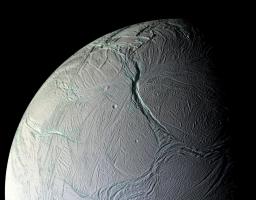 NASA scientists this week, made an exciting announcement. They have discovered the necessary chemical mix to potentially support life in the sea beneath a polar ice cap of Saturn’s moon, Enceladus. What they have observed on Enceladus is similar to the characteristics of deep-sea hydrothermal vents on Earth.
NASA scientists this week, made an exciting announcement. They have discovered the necessary chemical mix to potentially support life in the sea beneath a polar ice cap of Saturn’s moon, Enceladus. What they have observed on Enceladus is similar to the characteristics of deep-sea hydrothermal vents on Earth.
As the spacecraft Cassini passed by Enceladus, it recorded the chemical contents of gas plumes from the icy surface near the south pole. The plumes were primarily composed of water erupting through cracks in the surface ice. They are believed to originate from hydro-thermal vents in the Enceladus seafloor. In the latest recordings, the spacecraft Cassini also found significant hydrogen in the mix. Hydrogen is an important component to provide the energy to support life. With the addition of hydrogen, Enceladus appears to have all the right chemical building blocks for life. “Now, Enceladus is high on the list in the solar system for showing habitable conditions,” said Hunter Waite, leader of the Cassini Ion and Neutral Mass Spectrometer team at the Southwest Research Institute in San Antonio and lead author of the Enceladus study, to CNN.
Why do scientists think that life might exist on Saturn’s moons? Until, 1977, most thought that life needed light to exist. The deep seas were expected to be virtually lifeless, thanks to t he combination of darkness, high pressure and extreme cold. Then, scientists exploring the Galápagos Rift along the mid-ocean ridge in the eastern Pacific discovered deep-sea hydrothermal vents. These vents dramatically raised deep-ocean temperatures from near freezing to 400 °C (750 °F). As remarkable as the vents themselves, the hot water around the vents swarmed with life. Many of the organisms living around the vents were species that had never been observed before.
The existence of hydrogen on the plumes from Enceladus suggests strongly suggests the existence of hydrothermal venting and the potential to support life. Waite also commented, “The presence of hydrogen established another reference point saying there is hydrothermal activity inside this body, and that’s interesting because we know in our own oceans, those are very important places that are teeming with life, and they are probably one of the earliest places where life happened on Earth.”
Enceladus is the not the only moon where NASA has recently seen evidence of hydrothermal venting. Recent data from the Hubble space telescope, show similar plume venting on Europa, one of Neptune’s moons. The site of the venting closely aligns with a thermal hot-spot previously identified by the Galileo spacecraft.
